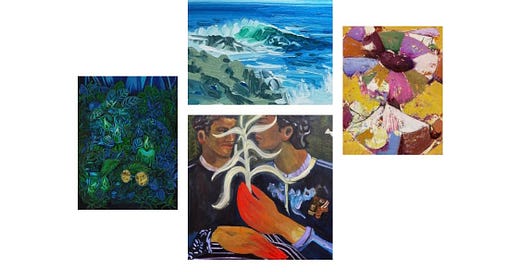I’ve started to notice a number of art startups, apps, and marketplaces insisting they’re selling “investment worthy” or “investment grade” art, and it worries me.
These phrases are vague and communicate something, but don’t promise it. When we hear investment we think “cha-ching! They’re selling art that I’ll buy for $1000 and sell for millions!”
But no matter what markets we’re talking about, it’s important to make clear that investing ≠ making money.
In a world where there’s increasingly more access to (and fluency in) retail investing in the stock market, I think it’s important we draw clear lines between investing in stocks and investing in art.
Let’s get a few things clear. When it comes to buying art:
There is no art market equivalent of the S&P 500 that will tell you what to invest in; no small cap and mid cap indices that gather companies to measure value as a grouping. (An equivalent might be to buy a whole bunch of artists with a certain set of credentials, but let’s also remember that in order to IPO a company undergoes rigorous vetting and disclosures— a CV with a Yale MFA on it is not that same thing.)
There is no passive investing— you can’t put your money into a fund and just let it grow. You have to do your research/know the market to buy savvily (and also know when to sell).
Art isn’t liquid— you can’t get cash for it at a moment’s notice, the way you can liquidate your stock portfolio.
Value for companies is for the most part measurable— that’s why when a company releases quarterly numbers, the stock reacts to those numbers. If a company is selling fewer widgets than it projected it would, the stock market value goes down. A company’s value is based on assets it owns (machinery, real estate, intellectual property, etc.), debts, sales, etc. There is not an equivalent in the art market. A company that goes bankrupt can sell its factory to recoup some money. I suppose you could sell a painting for parts, but what is canvas and a few paint chips “worth”? Value in art comes from much more abstract things.
Laws around advising and the fiduciary duty financial advisors have towards their clients (i.e. they have to have your best interest at heart) do not exist in the art market.
Oh, and you have to take care of your art for it to maintain value! No direct sun light, kids’ sticky fingers, not too hot, not too cold, not too humid, etc. No temperature control needed for your stock portfolio.
This might seem like a cynical post, or a self-sabotaging one (I do teach women to collect women artists as matrons of the arts, after all), but I think it’s important to be honest here.
I’m not saying that art can’t be invested in, or that you can’t make money off of selling it. I’m saying that we can’t approach it like the stock market and we shouldn’t expect to be able to.
It’s important to be clear about the conditions of what we’re talking about here so the joys we derive from it are based on what art really is about, not expectations of a return.
Investing in art (especially art by women) is investing in a world we want to see, one that acknowledges and celebrates female creativity. Investing in art is buying into a deeply satisfying, deeply introspective practice, that also connects us to other human beings. And the best part, living with art, as a certain actor said this week, can “get us to places we can’t get to any other way”.
All the things that make art collecting, buying, and investing unlike the stock market are what make it unlike anything else, period.






I really like that you brought this up, but I wish you'd almost delve further on the idea of "I’m saying that we can’t approach it like the stock market and we shouldn’t expect to be able to. " I really adored your book recommendation this summer, and I think if you delved further into the idea of how we should think about an investment in art, both financially and the intangible value that all of us feel from it, I think that would help us ALL get somewhere, if that makes sense.
I do agree with you that too many art companies focus on it from the financial side and it leaves the substance of the art like almost an afterthought. I love how you mention that we should invest in "a world we want to see" and I can't wait until the next post as always!
Well done and thought your point by point differences were honest. Something is obviously wrong when the price of a piece of art is the topic and not the art itself. Appreciate the reminder of focusing on what really matters and the substance of what the artist is saying.